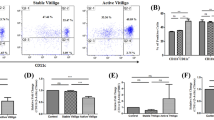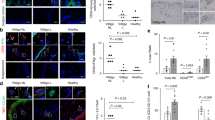Abstract
Vitiligo is a skin disorder with melanocyte destruction and an autoimmune basis. Given the importance of cytokines in autoimmunity, we aimed to find the cytokine profile of innate and adaptive immunity in vitiligo patients, and correlate them with clinical parameters. The serum levels of innate immunity [interleukin(IL)-1α, IL-1β, IL-6, IL-8, IL-12, IL-15 and tumor necrosis factor (TNF)-α] and T helper(Th)1 [IL-2, interferon (IFN)-γ, TNF-β], Th2 (IL-4, IL-5, IL-10, IL-13) and Th17 (IL-17, IL-23) cytokines in 44 vitiligo patients were measured by multiplex cytokine assay and compared with 44 healthy subjects. All innate immunity (p < 0.04), Th1 (p < 0.01), Th2 (p < 0.05) and Th17 (p < 0.001) cytokines were higher in patients than controls. Total summation levels of innate immunity and adaptive immunity cytokines showed a remarkable up-regulation in the patients (p < 0.0001). The ratio of innate immunity to Th1 (p = 0.03), Th2 (p = 0.01) and Th17 (p = 0.03) cytokines was significantly higher in patients vs. controls. We found significant higher ratio of Th1 to Th2 cytokines and TNF-β elevated levels in patients with a family history of autoimmunity (p < 0.05). IL-4 and IL-13 (p < 0.04) levels were lower in patients with amelanotic hair. Increased IL-10 level was observed in patients with stable disease (p = 0.02).
In conclusion, the profile of cytokines in patients showed a dominant role of innate immunity pro-inflammatory cytokines in vitiligo, which suggests the potential of targeting these cytokines for vitiligo treatment. While a higher ratio of Th1/Th2 cytokines was observed in the patients, association of decreased Th2 cytokines with disease complications suggests a protective role for Th2 pathway.





Similar content being viewed by others
References
Abreu ACG, Duarte GG, Miranda JYP, Ramos DG, Ramos CG, Ramos MG (2015) Immunological parameters associated with vitiligo treatments: a literature review based on clinical studies. Autoimmune Dis. https://doi.org/10.1155/2015/196537
Ala Y, Pasha MK, Rao RN, Komaravalli PL, Jahan P (2015) Association of IFN-γ: IL-10 cytokine ratio with Nonsegmental Vitiligo pathogenesis. Autoimmune Dis. https://doi.org/10.1155/2015/423490
Arora AK, Kumaran MS (2017) Pathogenesis of vitiligo: an update. Pigment Int 4(2):65–77. https://doi.org/10.4103/2349-5847.219673
Basak PY, Adiloglu AK, Ceyhan AM, Tas T, Akkaya VB (2009) The role of helper and regulatory T cells in the pathogenesis of vitiligo. J Am Acad Dermatol 60(2):256–260. https://doi.org/10.1016/j.jaad.2008.09.048
Birol A, Kisa U, Kurtipek GS, Kara F, Kocak M, Erkek E, Caglayan O (2006) Increased tumor necrosis factor alpha (TNF-α) and interleukin 1 alpha (IL1-α) levels in the lesional skin of patients with nonsegmental vitiligo. Int J Dermatol 45(8):992–993. https://doi.org/10.1111/j.1365-4632.2006.02744.x
Cengiz FP, Emiroğlu N, Çevirgen Cemil B, Erdem ÜGB, Kemeriz F (2014) Serum IL-23 levels in patients with vitiligo. Turkderm 48(4):204–207. https://doi.org/10.4274/turkderm.82957
Dardalhon V, Korn T, Kuchroo VK, Anderson AC (2008) Role of Th1 and Th17 cells in organ-specific autoimmunity. J Autoimmun 31(3):252–256. https://doi.org/10.1016/j.jaut.2008.04.017
Farhan J, Al-Shobaili H, Zafar U, Al Salloom A, Meki A, Rasheed Z (2014) Interleukin-6: a possible inflammatory link between vitiligo and type 1 diabetes. Br J Biomed Sci 71(4):151–157. https://doi.org/10.1080/09674845.2014.11669980
Harris JE (2016) Cellular stress and innate inflammation in organ-specific autoimmunity: lessons learned from vitiligo. Immunol Rev 269(1):11–25. https://doi.org/10.1111/imr.12369
Harris JE, Harris TH, Weninger W, Wherry EJ, Hunter CA, Turka LA (2012) A mouse model of vitiligo with focused epidermal depigmentation requires IFN-γ for autoreactive CD8+ T-cell accumulation in the skin. J Investig Dermatol 132(7):1869–1876. https://doi.org/10.1038/jid.2011.463
Iannella G, Greco A, Didona D, Didona B, Granata G, Manno A, Pasquariello B, Magliulo G (2016) Vitiligo: pathogenesis, clinical variants and treatment approaches. Autoimmun Rev 15(4):335–343. https://doi.org/10.1016/j.autrev.2015.12.006
Jadali Z (2015) IFN-γ Promotes Apoptosis of Melanocytes in Vitiligo. J Skin Stem Cell 2(4):e35719. https://doi.org/10.17795/jssc35719
Jordan SJ, Gupta K, Ogendi BM, Bakshi RK, Kapil R, Press CG, Sabbaj S, Lee JY, Geisler WM (2017) The predominant CD4+ Th1 cytokine elicited to Chlamydia trachomatis infection in women is tumor necrosis factor alpha and not interferon gamma. Clin Vaccine Immunol 24(4):e00010–e00017. https://doi.org/10.1128/CVI.00010-17
Karam RA, Zidan HE, Khater MH (2017) Genetic variants of interferon-gamma and its mRNA expression and inflammatory parameters in the pathogenesis of vitiligo. Biochem Cell Biol 95(4):474–481. https://doi.org/10.1139/bcb-2016-0228
Kasumagic-Halilovic E, Ovcina-Kurtovic N, Soskic S, Helppikangas H, Ridic O (2016) Serum levels of interleukin-2 and interleukin-2 soluble receptor in patients with vitiligo. Br J Med Med Res 13(10):1–7. https://doi.org/10.9734/BJMMR/2016/23959
Kemp EH, Waterman EA, Weetman AP (2001) Immunological pathomechanisms in vitiligo. Expert Rev Mol Med 3(20):1–22. https://doi.org/10.1017/S1462399401003362
Khan R, Gupta S, Sharma A (2012) Circulatory levels of T-cell cytokines (interleukin [IL]-2, IL-4, IL-17, and transforming growth factor-β) in patients with vitiligo. J Am Acad Dermatol 66(3):510–511. https://doi.org/10.1016/j.jaad.2011.07.018
Kolls JK, Lindén A (2004) Interleukin-17 family members and inflammation. Immunity 21(4):467–476. https://doi.org/10.1016/j.immuni.2004.08.018
Kumar R, Parsad D (2012) Melanocytorrhagy and apoptosis in vitiligo: connecting jigsaw pieces. Indian J Dermatol Venereol Leprol 78(1):19–23. https://doi.org/10.4103/0378-6323.90942
Le Poole IC, Replenishing MS (2017) Regulatory T cells to halt depigmentation in vitiligo. J Investig Dermatol Symp Proc 18(2):S38–S45. https://doi.org/10.1016/j.jisp.2016.10.023
Lili Y, Yi W, Ji Y, Yue S, Weimin S, Ming L (2012) Global activation of CD8+ cytotoxic T lymphocytes correlates with an impairment in regulatory T cells in patients with generalized vitiligo. PLoS One 7(5):e37513. https://doi.org/10.1371/journal.pone.0037513
Lotti T (2015) New frontiers in vitiligo treatment: the low dose cytokines-based therapy. Med Case Rep 2(2):18
Mohammed GF, Gomaa AH, Al-Dhubaibi MS (2015) Highlights in pathogenesis of vitiligo. World J Clin Cases 3(3):221–230. https://doi.org/10.12998/wjcc.v3.i3.221
Njoo MD, Westerhof W (2001) Vitiligo. Am J Clin Dermato 2(3):167–181. https://doi.org/10.2165/00128071-200102030-00006
Osman AM, Mukhtar MM, Bakheit KH, Hamdan HZ (2015) Plasma levels of interleukin-17, interleukin-23, and transforming growth factor-β in Sudanese patients with vitiligo: a case–control study. Indian J Dermatol 60(6):635. https://doi.org/10.4103/0019-5154.169136
Richmond JM, Frisoli ML, Harris JE (2013) Innate immune mechanisms in vitiligo: danger from within. Curr Opin Immunol 25(6):676–682. https://doi.org/10.1016/j.coi.2013.10.010
Schallreuter KU (2008) Viewpoint 1. Exp Dermatol 17(2):141–144. https://doi.org/10.1111/j.1600-0625.2007.00666_2.x
Singh M, Mansuri MS, Parasrampuria M, Begum R (2016) Interleukin 1-α: a modulator of melanocyte homeostasis in vitiligo. Biochem Anal Biochem. https://doi.org/10.4172/2161-1009.1000273
Singh RK, Lee KM, Vujkovic-Cvijin I, Ucmak D, Farahnik B, Abrouk M, Nakamura M, Zhu TH, Bhutani T, Wei M, Liao W (2016) The role of IL-17 in vitiligo: a review. Autoimmun Rev 15(4):397–404. https://doi.org/10.1016/j.autrev.2016.01.004
Singh S, Singh U, Pandey S (2012) Serum concentration of IL-6, IL-2, TNF-α, and IFNγ in vitiligo patients. Indian J Dermatol 57(1):12–14. https://doi.org/10.4103/0019-5154.92668
Speeckaert R, van Geel N (2017) Vitiligo: an update on pathophysiology and treatment options. Am J Clin Dermatol 18(6):733–744. https://doi.org/10.1007/s40257-017-0298-5
Spritz RA (2012) Six decades of vitiligo genetics: genome-wide studies provide insights into autoimmune pathogenesis. J Invest Dermatol 132(2):268–273. https://doi.org/10.1038/jid.2011.321
Tabarkiewicz J, Pogoda K, Karczmarczyk A, Pozarowski P, Giannopoulos K (2015) The role of IL-17 and Th17 lymphocytes in autoimmune diseases. Arch Immunol Ther Exp 63(6):435–449. https://doi.org/10.1007/s00005-015-0344-z
Tembhre MK, Sharma VK, Sharma A, Chattopadhyay P, Gupta S (2013) T helper and regulatory T cell cytokine profile in active, stable and narrow band ultraviolet B treated generalized vitiligo. Clin Chim Acta 424:27–32. https://doi.org/10.1016/j.cca.2013.05.005
Vaccaro M, Cannavò SP, Imbesi S, Cristani M, Barbuzza O, Tigano V, Gangemi S (2015) Increased serum levels of interleukin-23 circulating in patients with non-segmental generalized vitiligo. Int J Dermatol 54(6):672–674. https://doi.org/10.1111/ijd.12392
van den Boorn JG, Konijnenberg D, Dellemijn TA, van der Veen JP, Bos JD, Melief CJ, Vyth-Dreese FA, Luiten RM (2009) Autoimmune destruction of skin melanocytes by perilesional T cells from vitiligo patients. J Invest Dermatol 129(9):2220–2232. https://doi.org/10.1038/jid.2009.32
Veldhoen M, Hocking RJ, Atkins CJ, Locksley RM, Stockinger B (2006) TGFβ in the context of an inflammatory cytokine milieu supports de novo differentiation of IL-17-producing T cells. Immunity 24(2):179–189. https://doi.org/10.1016/j.immuni.2006.01.001
Wang CQ, Cruz-Inigo AE, Fuentes-Duculan J, Moussai D, Gulati N, Sullivan-Whalen M, Gilleaudeau P, Cohen JA, Krueger JG (2011) Th17 cells and activated dendritic cells are increased in vitiligo lesions. PLoS ONE 6(4):e18907. https://doi.org/10.1371/journal.pone.0018907
Wang L, Du F, Wang X (2008) TNF-α induces two distinct caspase-8 activation pathways. Cell 133(4):693–703. https://doi.org/10.1016/j.cell.2008.03.036
Yang L, Wei Y, Sun Y, Shi W, Yang J, Zhu L, Li M (2015) Interferon-gamma inhibits melanogenesis and induces apoptosis in melanocytes: a pivotal role of CD8+ cytotoxic T lymphocytes in vitiligo. Acta Derm Venereol 95(6):664–670. https://doi.org/10.2340/00015555-2080
Yu R, Broady R, Huang Y, Wang Y, Yu J, Gao M, Levings M, Wei S, Zhang S, Xu A, Su M, Dutz J, Zhang X, Zhou Y (2013) Correction: transcriptome analysis reveals markers of aberrantly activated innate immunity in vitiligo lesional and non-lesional skin. PLoS ONE 7(12):e51040. https://doi.org/10.1371/journal.pone.0051040
Zaba LC, Fuentes-Duculan J, Eungdamrong NJ, Abello MV, Novitskaya I, Pierson KC, Gonzalez J, Krueger JG, Lowes MA (2009) Psoriasis is characterized by accumulation of immunostimulatory and Th1/Th17 cell-polarizing myeloid dendritic cells. J Invest Dermatol 129(1):79–88. https://doi.org/10.1038/jid.2008.194
Acknowledgements
The authors of the paper would like to thank Mrs. Neda Kamali for her help in data entry and Dr. Eskandar Kamali-sarvestani for his support with this project. Shiraz University of Medical Sciences provided financial support for this study (Grant Numbers: 17-16022 and 17-16041).
Author information
Authors and Affiliations
Corresponding author
Ethics declarations
Conflict of interest
The authors declare no conflicts of interest. The authors alone are responsible for the content of this manuscript.
Ethical approval
All applicable international, national, and institutional guidelines for including patients and controls were followed.
Additional information
Publisher's Note
Springer Nature remains neutral with regard to jurisdictional claims in published maps and institutional affiliations.
Rights and permissions
About this article
Cite this article
Gholijani, N., Yazdani, MR. & Dastgheib, L. Predominant role of innate pro-inflammatory cytokines in vitiligo disease. Arch Dermatol Res 312, 123–131 (2020). https://doi.org/10.1007/s00403-019-01996-9
Received:
Revised:
Accepted:
Published:
Issue Date:
DOI: https://doi.org/10.1007/s00403-019-01996-9




